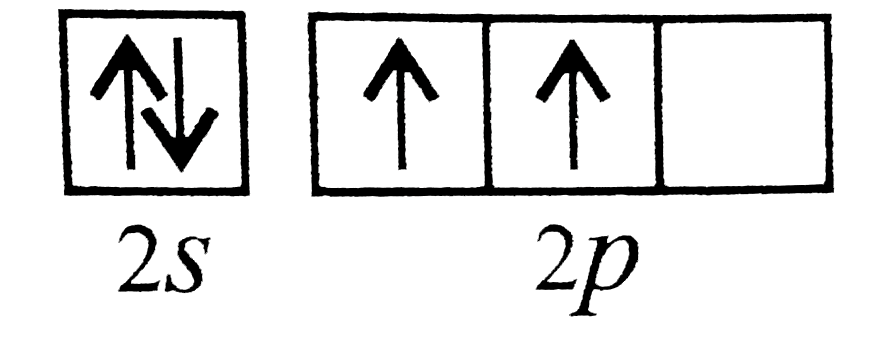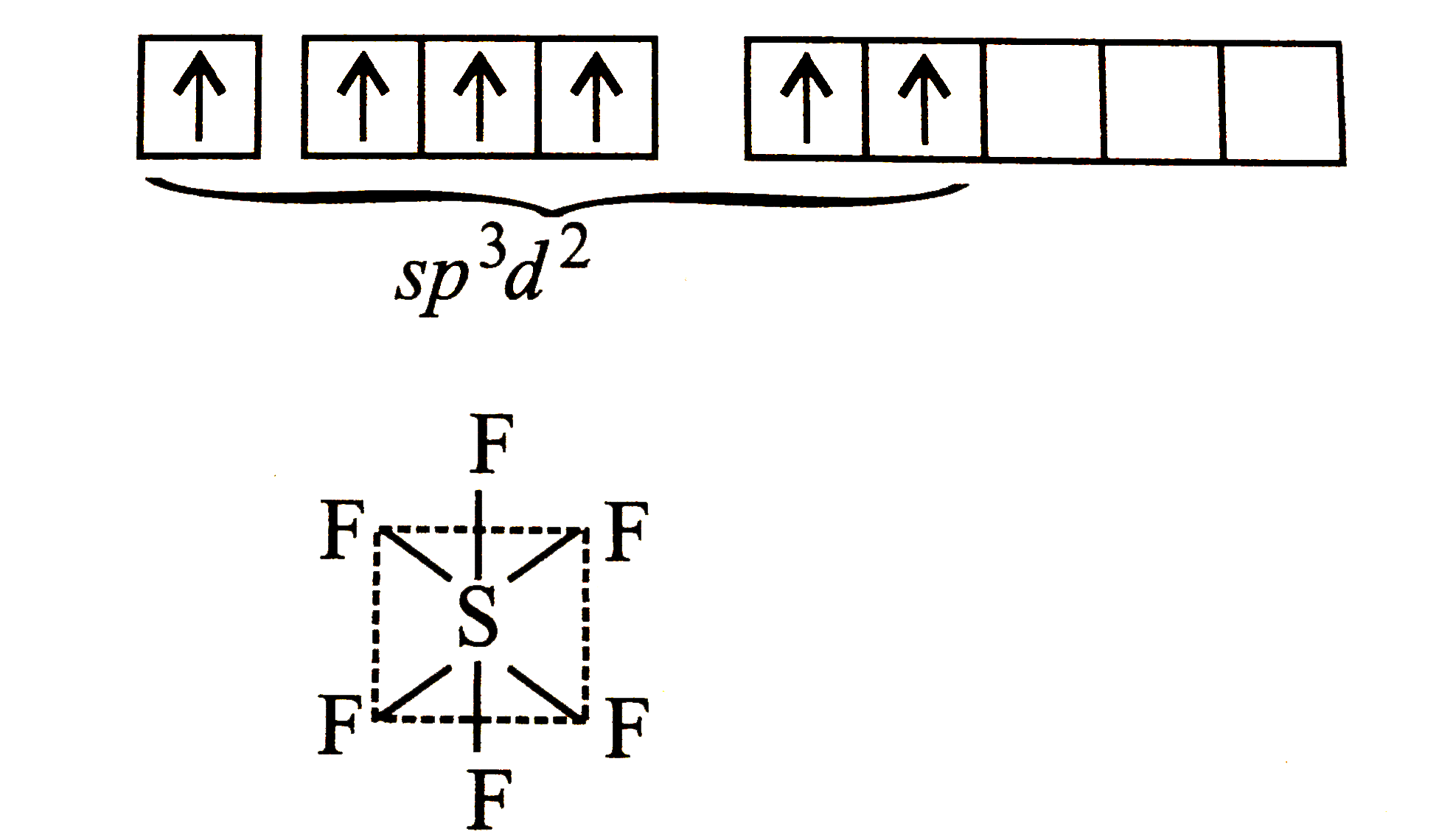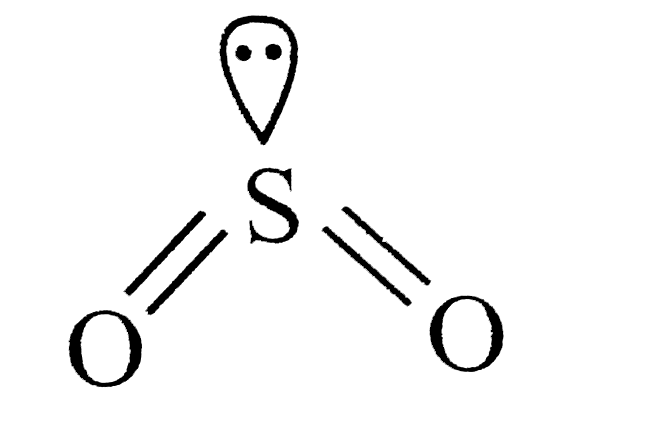Match the column I with column II and mark the appropriate choice.
Column IColumn II(A)C2H2(i)sp3d2 hybridisation(B)SF6(ii)sp3d3 hybridisation(C)SO2(iii)sp hybridisation(D)IF7(iv)sp2 hybridisation
(A)→(i),(B)→(iii),(C)→(ii),(D)→(iv)
(A)→(iii),(B)→(i),(C)→(iv),(D)→(ii)
(A)→(ii),(B)→(iii),(C)→(i),(D)→(iv)
(A)→(iv),(B)→(i),(C)→(iii),(D)→(ii)
The correct Answer is:B
In C2H2, undergoes, sp hybridisation.
Ground state

Excited state

H−C≡C−H
In SF6,S undergoes sp3d2 hybridisation.
Ground state

Excited state

In SO2, S undergoes sp2 hybridisation .

In IF7, I undergoes sp3d3 hybridisation.
Ground state

Excited state

Topper's Solved these Questions
- CHEMICAL BONDING & MOLECULAR STRUCTUREBOOK - NCERT FINGERTIPSCHAPTER - CHEMICAL BONDING & MOLECULAR STRUCTUREEXERCISE - Molecular Orbital Theory
18 Videos
- CHEMICAL BONDING & MOLECULAR STRUCTUREBOOK - NCERT FINGERTIPSCHAPTER - CHEMICAL BONDING & MOLECULAR STRUCTUREEXERCISE - Bonding In Some Homonuclear Diatomic Molecules
4 Videos
- CHEMICAL BONDING & MOLECULAR STRUCTUREBOOK - NCERT FINGERTIPSCHAPTER - CHEMICAL BONDING & MOLECULAR STRUCTUREEXERCISE - Valence Bond Theory
7 Videos
- CLASSIFICATION OF ELEMENTS AND PERIODICITY BOOK - NCERT FINGERTIPSCHAPTER - CLASSIFICATION OF ELEMENTS AND PERIODICITY EXERCISE - Assertion And Reason
15 Videos
Similar Questions
Sp^3d Hybridisation
View SolutionThe solutions of two compounds listed in column-I when taken in molecular proportions give coordination compounds on evaporation, Match these compounds with their properties listed in column-II.
Column-IColumn-II(A)[AuF4]−(p)dsp2hybridisation(B)[Cu(CN)4]3−(q)sp3hybridsation (C)[Ni(NH3)6]2+(r)sp3d2hybridisation(D)[Fe(H2O)5NO]2+(s)d2sp3hybridisation
View Solution
Knowledge Check
Match the column I with column II and mark the appropriate choice.
Column IColumn II(A)Fe(OH)3(i)Ksp=s2(B)Ag2CrO4(ii)Ksp=27s4(C)CH3COOAg(iii)Ksp=108s5(D)Ca3(PO4)(iv)Ksp=4s3A(A)→(iii),(B)→(ii),(C)→(iv),(D)→(i)B(A)→(ii),(B)→(iv),(C)→(i),(D)→(iii)C(A)→(i),(B)→(iii),(C)→(ii),(D)→(iv)D(A)→(iv),(B)→(i),(C)→(iii),(D)→(ii)sp3d2 hybridisation is present in
A[CoF6]−3B[Ni(CO)4]C[Co(NH3)6]+2D[Ni(CN)4]−2Match the compounds given in Column I with the hybridisation and shape given in Column II and mark the correct option.
Column IColumn II(A)XeF6(1)sp3d3−distorted octahedral(B)XeO3(2)sp3d2−square planar(C)XeOF4(3)sp3−pyramidal(D)XeF4(4)sp3d2−square pyramidalAA(1)B(3)C(4)D(2)BA(1)B(2)C(4)D(3)CA(4)B(3)C(1)D(2)DA(4)B(1)C(2)D(3)
SP Hybridisation |SP2 Hybridisation |SP3 Hybridisation
View SolutionMatch the compounds given in Column I with the hybridisation and shape given in Column II and mark the correct option.
Column IColumn II(A)XeF6(1)sp3d3−distorted octahedral(B)XeO3(2)sp3d2−square planar(C)XeOF4(3)sp3−pyramidal(D)XeF4(4)sp3d2−square pyramidal
View SolutionMatch the Column I with column II and mark the appropriate choice.
Column IColumn II(A)Coal gas(i)CO+H2(B)Synthesis gas(ii)CH4(C)Producer gas(iii)H2+CH4+CO(D)Natural gas(iv)CO+N2
View Solutionsp3d hybridisation result in
View SolutionMatch the column I with column II and mark the appropriate choice.
Column IColumn II(A)Borax(i)Na3AIF6(B)Inorganic benzene(ii)Na2B4O7.10H2O(C)Cryolite(iii)AI2O3.2H2O(D)Bauxite(iv)B3N3H6
View Solution
